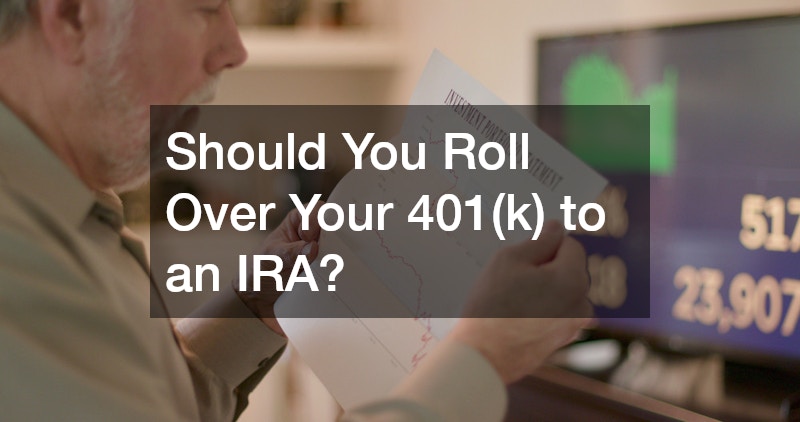

Reaching retirement is a major milestone—and if you’ve been contributing to a 401(k) throughout your career, you’ve likely built a valuable nest egg. But what happens next? Managing your 401(k) after retirement involves more than just cashing out. Decisions about rollovers, withdrawals, taxes, and investment strategies can significantly impact your financial security in retirement.
Whether you’re newly retired or planning ahead, this complete guide breaks down your options, answers common questions, and helps you make informed decisions. From minimum distribution requirements to whether you should leave your funds in the 401(k), this article is designed for finance-savvy individuals and curious planners alike.
Should You Leave Your Money in Your 401(k)?
When you retire, you don’t have to move your 401(k) right away. In fact, one of the first decisions you’ll make is whether to leave the money where it is.
Pros of Keeping Your Money in a 401(k):
- Tax-Deferred Growth: Your money continues to grow tax-deferred.
- Employer Plan Protections: 401(k)s typically have strong protection from creditors under federal law.
- Low Cost: Some employer-sponsored plans offer low-cost institutional funds.
Cons of Keeping Your Money in a 401(k):
- Limited Investment Options: Employer plans may have fewer investment choices.
- Administrative Restrictions: Some plans restrict withdrawal frequency or access to funds.
- Lack of Personalization: You may have limited control over fund allocation and strategy.
Good for: Those happy with their investment options and who don’t need immediate access.
Not ideal for: Those seeking more control or better customer service.
Should You Roll Over Your 401(k) to an IRA?

Rolling over your 401(k) to an IRA (Individual Retirement Account) is one of the most popular post-retirement strategies. It allows you to maintain tax-deferred growth while gaining more flexibility.
Benefits of a Rollover IRA:
- Wider Investment Options: IRAs give you access to thousands of funds, ETFs, and individual stocks.
- Simplified Management: Combine multiple 401(k)s into one IRA account for easier oversight.
- Potentially Lower Fees: You might save on administrative and management costs.
- Flexibility in Withdrawals: IRAs generally offer more withdrawal freedom.
Things to Consider:
- No Early Withdrawal Exemption: If you retire between 55 and 59½, 401(k)s allow penalty-free withdrawals. IRAs do not.
- Required Minimum Distributions (RMDs): Same age rules apply (usually age 73 as of 2025), but managing RMDs from multiple IRAs can be simpler.
Tip: Choose a direct rollover to avoid taxes and penalties.
What Are the Tax Implications of Withdrawing From a 401(k)?
Withdrawals from traditional 401(k) accounts are considered ordinary income. That means every dollar you take out is added to your taxable income for the year. This can have serious implications for your tax bracket and retirement income planning.
Key Tax Facts:
- Ordinary Income Tax: Withdrawals are taxed at your current income tax rate.
- No Penalty After 59½: You can begin penalty-free withdrawals at age 59½.
- Roth 401(k)s: If you held the account for at least 5 years, withdrawals are generally tax-free.
- RMDs Are Mandatory: At age 73 (or 75 for those born after 1960), you must start withdrawing.
Tax-Saving Strategies:
- Withdraw Strategically: Consider pulling from different accounts to minimize taxes.
- Roth Conversions: Convert some of your traditional 401(k) to a Roth IRA to reduce future taxable income.
- Use a Tax Professional: A tax advisor can help you avoid common pitfalls.
How to Turn Your 401(k) Into Retirement Income
You’ve spent decades growing your 401(k). Now it’s time to turn it into a reliable income stream. But how?
Common Income Strategies:
- Systematic Withdrawals
- Choose a percentage to withdraw each year, often based on the 4% rule.
- Annuities
- You can purchase an immediate or deferred annuity using a lump sum from your 401(k).
- Bucket Strategy
- Divide funds into short-term, medium-term, and long-term “buckets” for staged withdrawals.
- Interest and Dividend Income
- Invest in bonds or dividend stocks to generate passive income.
Pro Tip: Align your income strategy with your spending plan and life expectancy.
What Happens If You Delay Required Minimum Distributions?
If you don’t take your RMDs on time, the IRS imposes a 50% excise tax on the amount you failed to withdraw, one of the steepest penalties in the tax code.
Important RMD Notes:
- Start Age: Currently 73 (or 75 depending on your birth year).
- Deadline: April 1 of the year following the calendar year you turn the RMD age.
- Annual Requirement: Must continue yearly by December 31.
Managing RMDs Efficiently:
- Automate them with your IRA or plan provider.
- Consider Qualified Charitable Distributions (QCDs) to donate RMDs tax-free.
- Calculate carefully using the IRS Uniform Lifetime Table.
Should You Convert to a Roth IRA After Retirement?
Transferring funds to a Roth IRA from a traditional IRA or 401(k)—known as a Roth conversion—can be a smart financial move for some retirees. The main appeal is that future withdrawals from a Roth IRA are tax-free, which can be beneficial if you anticipate being in a higher tax bracket later on.
Benefits of a Roth IRA Conversion:
- Withdrawals Are Tax-Free in Retirement
Once qualified, distributions from a Roth IRA aren’t subject to income tax. - No Required Minimum Distributions (RMDs)
Roth IRAs don’t force withdrawals starting at age 73. - Helps with Legacy Planning
Beneficiaries can receive tax-free income, making it a useful estate planning tool.
Key Points to Think About:
- Taxes Are Due at the Time of Conversion
Any amount converted counts as taxable income for that year. - Spreading It Out May Be Wiser
Doing partial conversions over several years can help you stay in a lower tax bracket.
Best suited for: Retirees in lower income years who want to minimize future RMDs and leave a tax-free inheritance.
Can You Still Contribute to a 401(k) After Retirement?
In most cases, once you retire and are no longer earning income from work, you can’t contribute to your 401(k). However, if you work part-time or as a contractor and your employer offers a plan, contributions may still be possible.
Other Options:
- IRA Contributions: You can contribute to an IRA if you have earned income.
- Spousal IRA: If your spouse is still working, you may qualify for a spousal IRA.
What to Do With a 401(k) After a Spouse Passes Away
If you inherit a 401(k) from a spouse, you have several options. Understanding how to handle this situation is important to avoid costly tax mistakes.
- Spousal Rollover: You can roll the inherited 401(k) into your own IRA or 401(k) and treat it as your own.
- Inherited IRA: Alternatively, you may place the funds into an inherited IRA and follow distribution rules based on your age.
- Cash Out: You can also cash out, but this may result in a large tax bill.
Talk to a financial advisor or estate planner before making a decision.
How Social Security Affects 401(k) Withdrawal Strategy
Many retirees overlook the importance of coordinating Social Security with 401(k) withdrawals. The timing of your Social Security benefits can impact how much and when you withdraw from your 401(k).
- Delay Social Security: Waiting until age 70 increases monthly benefits.
- Bridge the Gap: Use 401(k) withdrawals in the early years to delay claiming Social Security.
- Tax Impact: Combining Social Security and 401(k) income can increase your tax liability.
Coordinate withdrawals to stay in a lower tax bracket and maximize benefits.
Should You Work With a Financial Advisor?

Navigating the rules around retirement income, RMDs, taxes, and investments can be overwhelming. A qualified financial advisor can help optimize your 401(k) withdrawals and plan for long-term stability.
Benefits of Professional Guidance:
- Tax Efficiency: Minimize the tax burden of withdrawals.
- Withdrawal Planning: Customize withdrawal amounts and timing.
- Asset Allocation: Ensure your portfolio remains appropriately balanced.
- Peace of Mind: Gain confidence knowing a professional is managing your strategy.
Look for a fee-only fiduciary who specializes in retirement planning.
What to Do With Your 401(k) After Retirement: Final Checklist
Here’s a simplified retirement 401(k) action plan to guide your decisions:
- Evaluate Whether to Keep or Rollover
- Understand Your Investment Options and Fees
- Plan Withdrawal Timing and Tax Impact
- Calculate and Prepare for RMDs
- Consider a Roth Conversion Strategy
- Work With a Financial Advisor
- Avoid Early Withdrawal Penalties
- Monitor and Adjust Annually
Common Mistakes to Avoid With Your 401(k) in Retirement
Knowing what not to do is just as important:
- Withdrawing too much too soon
- Ignoring tax consequences
- Missing RMD deadlines
- Overinvesting in volatile assets
- Not rebalancing your portfolio
- Failing to coordinate withdrawals with Social Security and pensions
Tip: Create a comprehensive retirement income plan that includes your 401(k), Social Security, pensions, and other savings.
Conclusion: Take Control of Your 401(k) After Retirement
Your 401(k) is one of your most powerful financial tools in retirement. But to get the most out of it, you need to make smart, informed decisions. Whether you leave your money in the plan, roll it into an IRA, or begin withdrawals, each choice has financial implications for your taxes, income, and long-term stability.
Plan carefully. Consult with a financial advisor. And above all, treat your 401(k) like the strategic asset it is—because what you do after retirement matters just as much as what you did before.